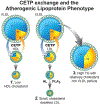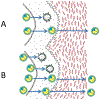Apolipoprotein B Particles and Cardiovascular Disease: A Narrative Review
- PMID: 31642874
- PMCID: PMC7369156
- DOI: 10.1001/jamacardio.2019.3780
Apolipoprotein B Particles and Cardiovascular Disease: A Narrative Review
Abstract
Importance: The conventional model of atherosclerosis presumes that the mass of cholesterol within very low-density lipoprotein particles, low-density lipoprotein particles, chylomicron, and lipoprotein (a) particles in plasma is the principal determinant of the mass of cholesterol that will be deposited within the arterial wall and will drive atherogenesis. However, each of these particles contains one molecule of apolipoprotein B (apoB) and there is now substantial evidence that apoB more accurately measures the atherogenic risk owing to the apoB lipoproteins than does low-density lipoprotein cholesterol or non-high-density lipoprotein cholesterol.
Observations: Cholesterol can only enter the arterial wall within apoB particles. However, the mass of cholesterol per apoB particle is variable. Therefore, the mass of cholesterol that will be deposited within the arterial wall is determined by the number of apoB particles that are trapped within the arterial wall. The number of apoB particles that enter the arterial wall is determined primarily by the number of apoB particles within the arterial lumen. However, once within the arterial wall, smaller cholesterol-depleted apoB particles have a greater tendency to be trapped than larger cholesterol-enriched apoB particles because they bind more avidly to the glycosaminoglycans within the subintimal space of the arterial wall. Thus, a cholesterol-enriched particle would deposit more cholesterol than a cholesterol-depleted apoB particle whereas more, smaller apoB particles that enter the arterial wall will be trapped than larger apoB particles. The net result is, with the exceptions of the abnormal chylomicron remnants in type III hyperlipoproteinemia and lipoprotein (a), all apoB particles are equally atherogenic.
Conclusions and relevance: Apolipoprotein B unifies, amplifies, and simplifies the information from the conventional lipid markers as to the atherogenic risk attributable to the apoB lipoproteins.
Figures








References
Publication types
MeSH terms
Substances
Grants and funding
LinkOut - more resources
Full Text Sources
Other Literature Sources
Medical
Miscellaneous

